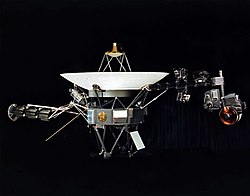Interstellar medium

In astronomy, the interstellar medium (sometimes called the ISM) is the tenuous gas and dust that fills the void between stellar systems in galaxies, that consisting mainly of huge clouds of ionized, neutral, or molecular hydrogen.[1][2] This gas and dust not distributed uniformly in interstellar space, but displays significant variations in density, temperature, and ionisation state.[2]
Various gases exist in outer space. Most common are hydrogen and helium. Interstellar cosmic dust makes nebulae.
Interstellar Medium Media
The distribution of ionized hydrogen (known by astronomers as H II from old spectroscopic terminology) in the parts of the Galactic interstellar medium visible from the Earth's northern hemisphere as observed with the Wisconsin Hα Mapper (Haffner and others 2003).
Voyager 1 is the first artificial object to reach the interstellar medium.
Three-dimensional structure in Pillars of Creation.
Map showing the Sun located near the edge of the Local Interstellar Cloud and Alpha Centauri about 4 light-years away in the neighboring G-Cloud complex
Interstellar medium and astrosphere meeting
Short, narrated video about IBEX's interstellar matter observations.
Atmospheric attenuation in dB/km as a function of frequency over the EHF band. Peaks in absorption at specific frequencies are a problem, due to atmosphere constituents such as water vapor (H2O) and carbon dioxide (CO2).
Herbig–Haro object HH 110 ejects gas through interstellar space.
This light-year-long knot of interstellar gas and dust resembles a caterpillar.
References
- ↑ "Definition of interstellar medium | Dictionary.com". www.dictionary.com. Retrieved 2020-10-05.
- ↑ 2.0 2.1 Snell, Ronald L. (2011). Gargaud, Muriel; Amils, Ricardo; Quintanilla, José Cernicharo; Cleaves, Henderson James (Jim); Irvine, William M.; Pinti, Daniele L.; Viso, Michel (eds.). Encyclopedia of Astrobiology. Berlin, Heidelberg: Springer. pp. 837–843. doi:10.1007/978-3-642-11274-4_801. ISBN 978-3-642-11274-4.







